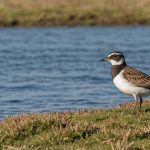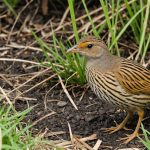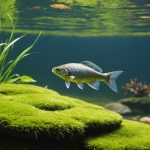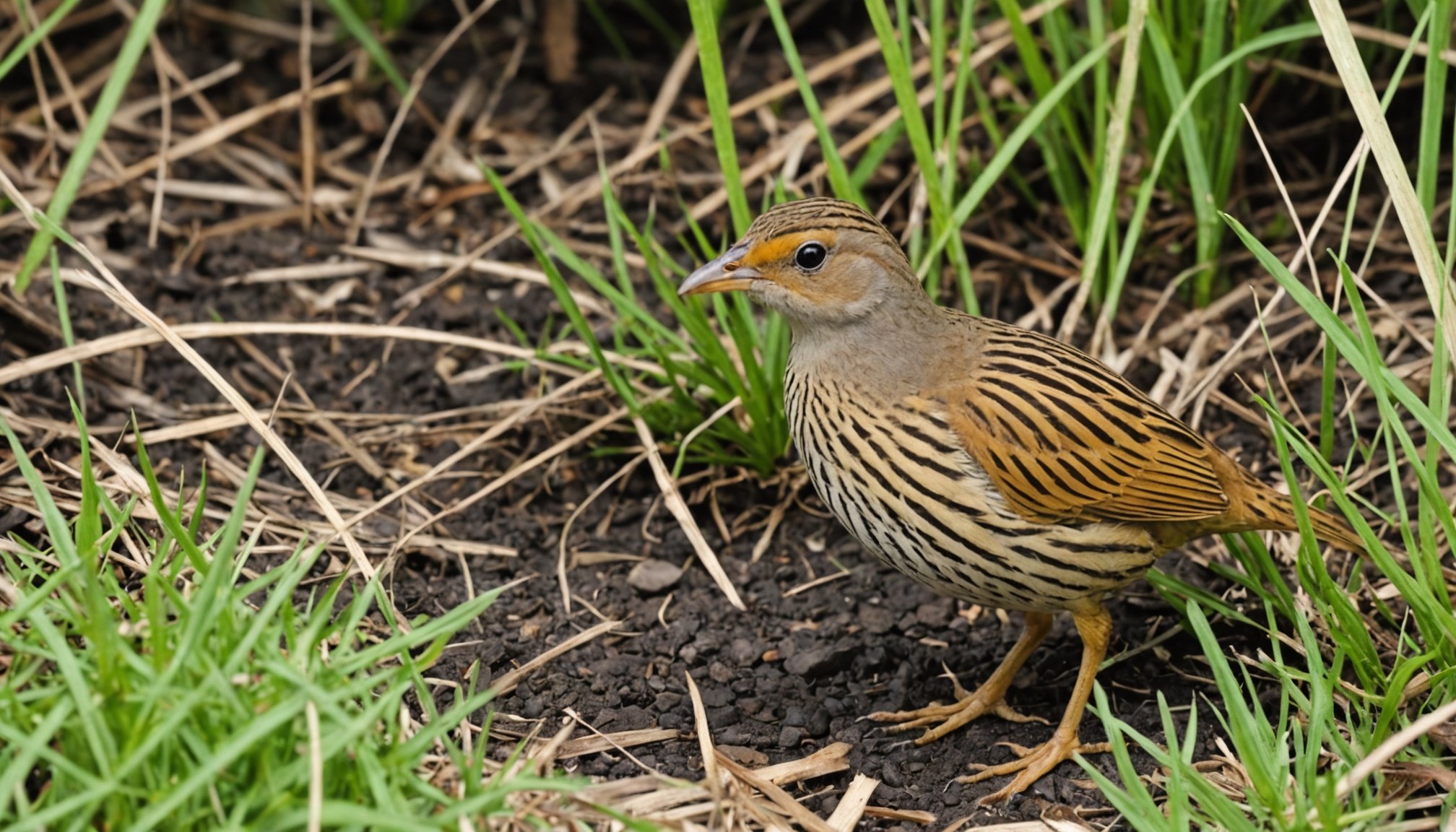Overview of the Corncrake Conservation Status
The corncrake population has faced significant challenges, making it a focal point of conservation efforts. Over recent decades, there’s been a marked decline in numbers, primarily driven by habitat loss and agricultural developments. These changes have pushed the corncrake into the endangered species category, prompting immediate intervention.
Corncrakes, known for their elusive nature and distinctive calls, play a crucial role in their ecosystems. They contribute to the health of biodiversity by participating in the food web and assisting in the natural control of insect populations. Their presence indicates a rich, well-balanced habitat. Hence, conserving corncrakes is not just about preserving a species, but about maintaining biodiversity itself.
Also to read : Exploring the effects of climate change on coastal bird populations in the uk: a deep dive into the consequences
Several factors have contributed to the corncrake’s precarious status. Predominantly, habitat destruction due to intensified agricultural practices poses the most significant threat. Additionally, the shift towards earlier mowing times reduces the nesting and breeding success of these birds. Climate change and predation further compound their vulnerability.
Sustained conservation efforts, including habitat restoration and legal protections, are critical in reversing these trends. By fostering awareness and taking active measures, we can ensure that corncrakes continue to enrich our environment and sustain biodiversity.
Also to read : Top fish varieties for uk ponds: boost your local ecosystem with these ideal selections
Key UK Zoos and Their Breeding Programs
In the heart of UK conservation efforts, several zoos have emerged as pivotal players in the breeding of endangered species including the elusive corncrake. These esteemed institutions are leading the charge, not only in safeguarding the future of these vulnerable creatures but also in employing innovative techniques that enhance survival rates.
Primary Zoos Involved in Corncrake Breeding
ZSL London Zoo, Chester Zoo, and Edinburgh Zoo are among the prominent UK zoos diligently participating in corncrake breeding programs. These institutions are renowned for their commitment to endangered species conservation, implementing a variety of tailored breeding programs aimed at reintroducing healthy populations into the wild.
Breeding Techniques and Success Rates
The success of these programs heavily relies on specialized breeding techniques. These include controlled environmental settings simulating natural habitats, cross-fostering to encourage acceptance of offspring, and genetic monitoring to maintain diverse gene pools. The results are promising. For example, Chester Zoo reports consistent success in not only the birth rates of corncrakes but also their reintegration into native habitats. Such accomplishments underscore the critical role that UK zoos play in preventing extinction and ensuring ecological balance.
Furthermore, innovative techniques and adapting to ecological changes reflect the dynamic capabilities of zoos in tackling the challenges of biodiversity conservation.
Methodologies in Corncrake Breeding
Initiatives to conserve corncrakes heavily rely on breeding methodologies that ensure robust populations. These strategies often emphasize the importance of maintaining genetic diversity. This diversity is crucial as it reduces the likelihood of hereditary diseases and enhances adaptability to environmental changes, thereby increasing the species’ chances of long-term survival.
Key practices in zoos include carefully managed pairings based on genetic data, to prevent inbreeding. By using conservation techniques such as cross-regional mating programs, zoos can promote a more varied gene pool across different sites, enhancing the overall vitality of this remarkable bird.
Moreover, practitioners have begun integrating innovative techniques adapted specifically for corncrakes. These include methods such as artificial insemination and the implementation of climate-controlled breeding environments. Such approaches mimic natural conditions, which can encourage more natural behaviours during breeding. Another approach includes using soundscapes that replicate the corncrakes’ natural habitats, encouraging mating rituals.
By adopting these conservation techniques, zoos and breeding centers not only contribute to the growth of corncrake populations but also provide a foundation for research and further innovation in wildlife preservation efforts. The combination of traditional practices with cutting-edge technologies demonstrates a compelling commitment to the sustainability of corncrakes and their environments.
Scientific Research and Collaboration
Diving into the realm of scientific studies reveals a network of collaboration driving breeding programs. This collaboration spans zoos, universities, and conservation organizations, forming a robust framework for sustainable conservation efforts.
Central to these efforts is the intricate web of research collaboration. Zoos and academia often team up, pooling resources and expertise to better understand species needs and breeding requirements. This synergy is crucial for developing effective strategies to bolster population numbers of endangered species. Furthermore, conservation organizations play a pivotal role in translating research findings into actionable policies, enhancing the relevance and impact of these studies.
A vivid example is the collaboration between the Smithsonian’s National Zoo and George Mason University. Their joint research programs focus on conservation science, investigating breeding behaviours and habitats specific to vulnerable species. This partnership has yielded invaluable insights, benefiting global conservation tactics.
Case studies further underscore the importance of these efforts. The California Condor Recovery Program, for instance, showcases how international research collaboration has significantly boosted condor populations. These empirical insights underline the necessity of collaborative research and its potential to drive successful conservation initiatives.
Through these partnerships, scientific research continues to form the backbone of conservation science, offering tangible solutions and hope for endangered species globally.
Challenges Faced in Breeding and Conservation
Corncrakes face numerous conservation challenges, threatening their future. A significant issue is habitat loss, substantially impacting breeding success. These birds rely on specific tall grass meadows for nesting, which are increasingly being plowed for agriculture, thereby diminishing vital habitats. Changes in farming practices often lead to the destruction of nests during crucial breeding periods.
Furthermore, breeding difficulties arise from fewer available environments and increased predation. As their habitats shrink, corncrakes find fewer safe spots to raise their young. This not only reduces numbers but also affects genetic diversity, critical for adapting to changing environments.
Strategies to combat these challenges focus on habitat restoration and protection. Efforts include establishing protected areas where agricultural practices are controlled to ensure compatibility with corncrake needs. In some regions, farmers receive incentives to delay mowing until after breeding season.
Conservation groups are also working to raise awareness about these threats to species, educating communities on their importance to biodiversity. Collaboration between conservationists and landowners is crucial. By implementing these strategies, there’s hope for stabilizing, and eventually increasing, corncrake populations. Efforts continue to adapt to new challenges as they arise, ensuring the preservation of this unique species.
Success Stories and Their Impact
In the realm of wildlife conservation, success stories serve as a beacon of hope and inspiration. One such triumph can be found in the concerted efforts to protect and revive the corncrake population.
The story of strategic breeding and reintroduction illustrates a prime example of positive outcomes. In certain regions, controlled breeding programs have successfully increased corncrake numbers, enabling them to re-establish themselves in parts of their former range. The meticulous process of ensuring genetically diverse and healthy offspring has been pivotal in these programs. Following breeding, carefully monitored reintroduction into protected habitats has allowed these elusive birds to flourish once more.
The profound impact of these success stories on the corncrake population cannot be overstated. An increase in population sizes is not only a win for conservationists but underscores the significance of strategic habitat management. Moreover, these triumphs foster a ripple effect, encouraging the safeguarding of other threatened species through similar methods.
Insights from involved conservationists have been invaluable in shaping these efforts. They highlight the importance of tailoring strategies to each unique ecosystem and stress the necessity of community engagement. Through shared knowledge and collaboration, more positive outcomes can be realised, weaving a narrative of hope in wildlife conservation.
Future Directions in Corncrake Conservation
In focusing on future conservation efforts for the corncrake, UK zoos are central to creating effective long-term strategies. A priority is ensuring that these initiatives are sustainable, benefiting not just the current populations, but promoting resilience for future generations.
Discussion on Future Plans
UK zoos are investing in breeding programmes as part of their long-term strategies. These efforts are tailored to sustainability, reducing reliance on wild populations by boosting numbers in captivity. With time, strategic releases can augment wild populations, stabilising numbers in critical habitats.
Importance of Long-Term Commitment
Long-term commitment is key in any conservation. It involves not only immediate actions but also consistent monitoring and adjusting of strategies as necessary. This ongoing dedication ensures that populations remain stable and ready to respond to environmental changes.
Sustainable Practices
Sustainable practices are deeply integrated with these efforts; they include habitat restoration and protection, which are essential for supporting corncrake populations in the wild. By restoring natural habitats, these efforts also encourage other local wildlife to thrive, enhancing overall ecosystem health.
Such thorough and future-oriented strategies are necessary for achieving meaningful results in the conservation of the corncrake, ensuring they continue to be a part of our natural world.











